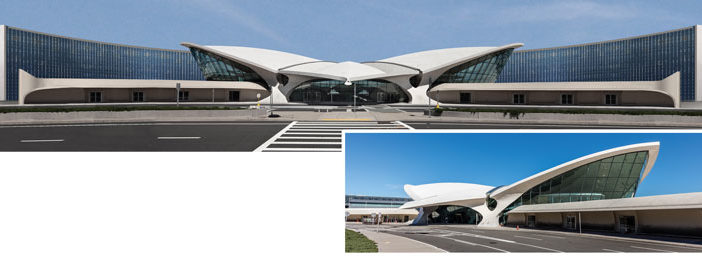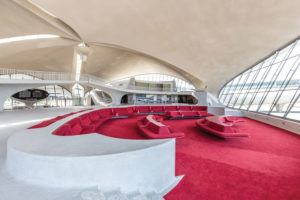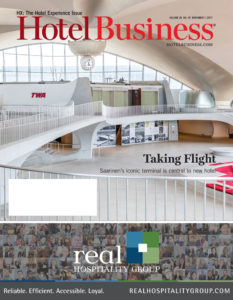Maybe it’s because he was once a baggage handler at LAX for Delta Air Lines that Tyler Morse decided to take on one of the most-complicated, precedent-setting airport-hotel projects New York City has ever seen.
While dozens of years and thousands of miles now separate the Los Angeles native from his early days (gently) tossing suitcases on the West Coast, the now CEO/managing director of MCR/Morse Development recently still found himself doing some pretty heavy lifting, this time at NYC’s John F. Kennedy International Airport. It’s where his team is redeveloping the iconic Eero Saarinen-designed TWA (Trans World Airlines) Flight Center terminal, converting it into the frontispiece of a double-building, 505-room property set to open as the TWA Hotel in 2019.
MCR snagged the deal in 2015 by winning an RFP that saw competitors including The Related Cos., Ian Schrager, Steve Witcoff of Witcoff Group and Donald Trump as contenders.
The rehabilitation/restoration/construction plan is a privately funded investment by MCR of approximately $265 million that will revitalize the 1962 cutting-edge architectural gem and recreate its mid-century modern design aesthetic while bringing the existing building up to code. This includes restoring the Flight Center’s interiors, with aspects created by now-legendary designers Charles Eames, Warren Platner, Florence Knoll and Raymond Loewy. The interiors have been in abeyance since the terminal was closed to the public in 2001 after TWA was sold to American Airlines following—among other financial distress—two bankruptcies in the 1990s.
A public/private partnership with the Port Authority of New York and New Jersey, which operates the airport, the MCR venture also is delivering the first on-site hotel to JFK since the airport opened in Jamaica, Queens, as New York International Airport (aka Idlewild Airport) in 1948. (A year after the TWA terminal opened, the airport was renamed in honor of the assassinated president.)
The TWA Flight Center was designated a New York City landmark in 1994 and went on the National Register of Historic Places in 2005.
“We are bringing her back to life,” said Morse, who praised the Port Authority for protecting the building from threats of demolition over the years.
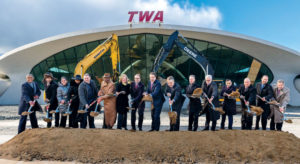
MCR/Morse Development CEO/Managing Partner Tyler Morse and New York State Governor Andrew Cuomo (center, left and right) dig in along with other dignitaries and executives during last December’s groundbreaking for the TWA Hotel at John F. Kennedy International Airport. Photo: Max Touhey
That resuscitation effort has not been without its blips, with MCR, the lead investor, having to coordinate with a roster of parties, including nine law firms, 22 federal, state and city agencies, four design firms and 124 consulting firms.
“There’s no public funding, but there’s public help in getting through the process, and that’s sometimes more important than not,” said the CEO.
Earlier this year, when he drilled down the litany of adjunct interests MCR needed to wrangle for approvals during a panel at the NYU International Hospitality Industry Investment Conference in June, there were audible groans from the audience, with many shaking their heads as if to ask why go through all that.
And Morse has some answers for that.
“We live in a celebrity culture these days, and the celebrity of our project is Eero Saarinen’s masterpiece,” said the CEO. He noted the Flight Center has the added cachet of having been built by industry-straddling tycoon Howard Hughes, who owned TWA from 1937 to 1968. “It was really a family business, which is one of the reasons it thrived. He kept the TWA culture together. It was TWA versus Pan Am in an epic struggle for the skies,” enthused the CEO.
Morse, who fondly recalled sipping a Shirley Temple on the upper deck of a TWA 747 as a child, exuded a tone of affection when describing the Flight Center’s creator.
“Eero Saarinen is one of the most prolific architects of our age. He was only alive for 51 years [he died in September 1961 before seeing the TWA terminal completed]and the impact that he had on both America and the world was just transformative as part of the mid-century modern design movement,” he said.
Among the venerated architect’s other notable designs are the St. Louis Arch, Dulles Airport, the CBS Corp.’s “Black Rock” headquarters building on Sixth Ave. in Manhattan, IBM’s headquarters in Rochester, NY, John Deere’s headquarters in Moline, IL, and the U.S. Embassy in London in Grosvenor Square.
The TWA Flight Center sits on 6.5 acres and its gull-wing “shell” provides columnless space that will be used as the hotel’s lobby.
“There are only four points of contact with the ground so it’s really the ‘eighth wonder of the world’ from a structural standpoint,” said Morse, adding it was originally designed to accommodate 17,000 persons flowing in and out at any given time.
“Our building was designed around the Lockheed Constellation [designed by Hughes], a 45-seat aircraft that goes 300 miles per hour; that was in 1956. By the time the building opened in 1962, the Boeing 707 was the aircraft du jour. It held 100 people and went 500 miles per hour. So the building was functionally obsolete the day it opened,” said Morse. “It was designed around a four-engine, propeller aircraft and by the time the building opened, we were in the Jet Age.”
That said, a vintage Lockheed “Connie” is being retrofitted to house a restaurant and bar at the TWA Hotel site. While that is likely to be the “crown jewel” of the hotel’s F&B operations, there will be no shortage of culinary experiences offered.
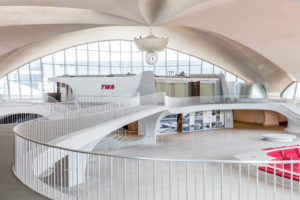
The multi-level terminal/lobby will incorporate a variety of F&B outlets when the hotel opens. Photos: by Max Touhey
Six to eight F&B outlets are slated for the property’s lobby. In addition, MCR is reviving several of the Flight Center’s original gathering spots: the Ambassador’s Club, which features orange-cushioned, white Saarinen-designed Tulip Chairs and an Isamu Noguchi green marble fountain in the first-class lounge; the Lisbon Lounge; and the Raymond Loewy-designed Paris Café.
Also expected to be a draw for travelers and locals alike is the revival of the Constellation Club, where dining and dancing will be offered a la 1960s-era nightclubs.
“The Jet Age came of age in 1962 right here in New York City, and that’s what we’re focusing on from a design standpoint; we’re bringing the ethos of 1962 back to this building,” said Morse.
For example, the hotel’s reception desk will channel the original Loewy-designed TWA ticket counters.
Current architects involved in the hotel project are Brooklyn, NY-based Lubrano Ciavarra Architects and New York City-based Beyer Blinder Belle Architects and Planners LLP.
To further bring that Jet Age vibe into the current consciousness, the restored Flight Center will house a museum dedicated to the period, with a focus on the history of TWA, the city and the mid-century modern design movement.
MCR recently offered a glimpse of what that would entail with the debut of the TWA Lounge at One World Trade Center in lower Manhattan. Pulling in some of the Flight Center’s signature features, such as the streamlined chili pepper red-cushioned “sunken” seating—this time without ’60s de rigueur ashtrays—a Solari display board showing flights (which will be installed in the hotel’s lobby) and a raft of TWA memorabilia. The latter included a collection of vintage flight-attendant uniforms that also showcased four short-lived “Foreign Accents” paper uniforms that had descriptors such as: French Cocktail, Roman Toga, British Wench and Manhattan Penthouse Pajamas.
The custom-designed space, created by Lubrano Ciavarra Architects on the 86th floor, is geared toward previewing the property for meeting and event planners by the hotel’s sales team.
“We created the space to bring a bit of Saarinen and mid-century modern to the city and to have a connection point from Manhattan to Kennedy, and specifically for event-planning purposes,” said Morse. The CEO noted the office has a direct sight line to JFK Airport. “It’s 12 miles as the crow flies,” he said.
The hotel also will offer a 50,000-sq.-ft. event center, which Morse characterized as “the largest event center built on Long Island since the Nassau Coliseum.” One advantage to the center is that it will be on what is known as the airport’s “land side” as opposed to “air side,” so it is outside of security constraints.
It is being built below grade between the futuristic Saarinen-designed tubes passengers once used as walkways to their flights and which will connect the hotel, the Flight Center/lobby and JetBlue’s Terminal 5. (JetBlue Airways Corp. is a 5% partner in the TWA Hotel venture, which is on a 75-year lease.) The space will be able to accommodate 1,600 persons.
“We think we’re going to have a lot of local events,” said Morse. “I think we’re going to get a lot of plane-spotters. I think we’re going to do 100 weddings a year, 50 bar mitzvahs a year. We’ll have a big social business. All roads lead to JFK Airport, 150,000 people fly out of JFK every single day, and there are 3.5 million people who live in the local community, not including Manhattan.
“If you go to architecture school in Tokyo or Cairo, you study this building; this is such a fascinating piece of architectural history. We’ve designed the event space with all that in mind,” said the CEO.
There also will be a 10,000-sq.-ft. fitness facility; 10,000-sq.-ft. public observation deck with views to the airport runways and the Saarinen building; and retail outlets that will be part of the lobby landscape.
The hotel will have its own power plant and is anticipating it will achieve LEED certification.
And any concerns for the noise level impacting sleeping guests were put to bed by the chief executive.
“A giant piece of glass with seven sheets to it, that’s going to be the curtain wall of the hotel rooms, which is going to maintain complete and total silence in the rooms. It’s actually going to be the quietest hotel room you’ve ever stayed in,” predicted Morse, noting the curtain wall is built to a higher STC (Sound Transmission Class) rating than at a Four Seasons Hotel.
“It’s a terrific project, but it’s also been very hard fought,” observed Morse in assessing the venture.
“When we got to the building, it was filled with asbestos, it was filled with lead paint. TWA had taken a lot of shortcuts when it came to the heating and air conditioning systems. And it was 60 years old,” he said. Since then, the asbestos has been abated, the lead paint removed and the HVAC is being replaced. The iconic window glass (486 panes) has been replaced with tempered glass.
“We’re spending $65 million just to bring the building up to today’s standards,” said Morse. “It’s a historically accurate restoration of the building and we’re going to take very good care of it.”
He cited MCR’s financial capacity to execute the project, development expertise to build the project and historic-preservation capabilities (MCR recently did an adaptive-reuse of an Episcopalian seminary in NYC’s Chelsea district that delivered The High Line Hotel) among the reasons the multifaceted project was given to MCR/Morse Development.
“I think we had a skill set that met the needs of this project quite nicely,” said the executive, although he observed, “It takes a village to do a project like this.”
The project went vertical in mid-October and it’s expected the six-story hotel buildings will top out in December.
Turner Construction is serving as general contractor.
“We’ll be open in 18 months and the whole project will open at the same time,” said Morse.
The hotel is being built with union labor and will be operated by the Hotel Trades Council.
“It’s one of the most special buildings in the United States, and the ability to bring it back to life is really a once-in-a-lifetime opportunity,” said Morse.
Heading in this high-end hotel direction is now complementing MCR’s portfolio of 90 hotels in 23 states, which is focused on select-service properties largely under Hilton and Marriott International brands. MCR will continue to acquire hotels in that segment, said Morse. “We acquired a couple of hotels in Salt Lake City and a couple of weeks ago, we opened a Residence Inn by Marriott in Ft. Lauderdale, FL. So, we’re quite busy,” he said.
Indeed. At press time, the owner/operator put down $12.5 million to acquire a 120-key Hampton Inn & Suites by Hilton in Mount Pleasant, a suburb of Chicago. HB

